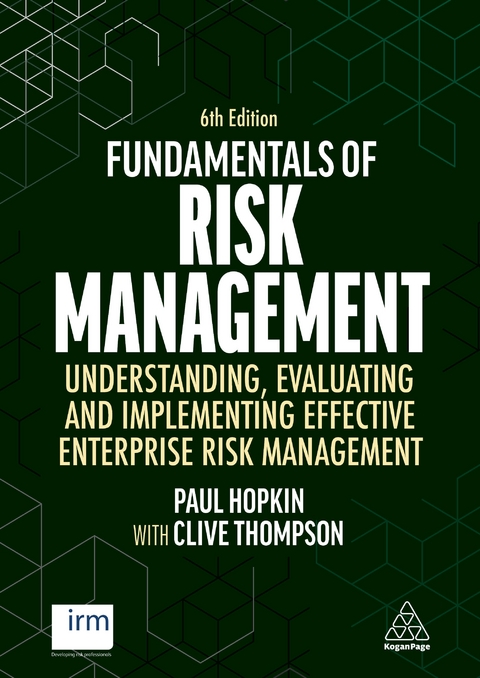
Fundamentals of Risk Management
Kogan Page Ltd (Verlag)
978-1-3986-0288-5 (ISBN)
- Titel erscheint in neuer Auflage
- Artikel merken
Available for students taking the Institute of Risk Management's International Certificate in Enterprise Risk Management. This is specifically for those taking the examination in June 2025.
Effective risk management allows opportunities to be maximized and uncertainty to be minimized.
This guide for emerging professionals provides a comprehensive understanding of risk management with tools, tips and tactics on how to offer expert insights and drive success in an ever-changing area, covering everything from Covid-19 and digitization to climate change.
Fundamentals of Risk Management is a detailed and comprehensive introduction to commercial and business risk for students and risk professionals. Completely aligned with ISO 31000 and the COSO ERM Framework, this book covers the key principles of risk management and how to deal with the different types of risk organizations face. The frameworks of business continuity planning, enterprise risk management, and project risk management are covered alongside an overview of international risk management standards and frameworks, strategy and policy.
The revised sixth edition includes brand new content on trends such as cyber risk, black swan events and climate risk. It has been fully updated to place the emphasis on seeing risk as 'positive' rather than a 'constant threat', and establishes that risk is different in a digital/VUCA age. Additionally, it considers in detail the impact of the climate crisis and its effect on risk management activities.
Further updates from the previous edition include brand new case studies on the failure of Arcadia, HBO's bankruptcy and Boohoo's issues with modern slavery, this book provides a full analysis of changes in contemporary risk areas including digital risk management, risk culture and appetite, supply chain and statutory risk reporting. Supporting online resources include lecture slides with figures, tables and key points from the book
Clive Thompson was founding Chair of the Professional Standards and the Interest Group Committees of the Institute of Risk Management where he served on the board and was Deputy Chair until 2020. Based in West Sussex, UK, he has been a risk manager and consultant delivering projects globally. He is a Certified Fellow of the IRM.
Section - ONE: Introduction to Risk Management;
Chapter - 01: Approaches to Defining Risk;
Chapter - 02: Impact of Risk on Organizations;
Chapter - 03: Types of Risks;
Chapter - 04: Scope of Risk Management;
Chapter - 05: Principles and Aims of Risk Management;
Section - TWO: Approaches to Risk Management;
Chapter - 06: Risk Management Standards;
Chapter - 07: Establishing the Context;
Chapter - 08: Enterprise Risk Management;
Chapter - 09: Alternative Approaches;
Section - THREE: Risk Assessment;
Chapter - 10: Risk Assessment Considerations;
Chapter - 11: Risk Classification Systems;
Chapter - 12: Risk Analysis and Evaluation;
Chapter - 13: Loss Control;
Chapter - 14: Defining the Upside of Risk;
Section - FOUR: Risk Response;
Chapter - 15: Tolerate, Treat, Transfer and terminate;
Chapter - 16: Risk Control Techniques;
Chapter - 17: Insurance and Risk Transfer;
Chapter - 18: Business Continuity;
Section - FIVE: Risk Strategy;
Chapter - 19: Core Business Processes;
Chapter - 20: Reputation and the Business Model;
Chapter - 21: Risk Management Context;
Chapter - 22: Risk Management Responsibilities;
Chapter - 23: Control of Selected Hazard Risks;
Section - SIX: Risk Culture;
Chapter - 24: Risk-Aware Culture;
Chapter - 25: Importance of Risk Appetite;
Chapter - 26: Risk Training and Communication;
Chapter - 27: Risk Practitioner Competencies;
Section - SEVEN: Risk Governance;
Chapter - 28: Corporate Governance Model;
Chapter - 29: Stakeholder Expectations;
Chapter - 30: Operational Risk Management;
Chapter - 31: Project Risk Management;
Chapter - 32: Supply Chain Management;
Section - EIGHT: Risk Assurance;
Chapter - 33: The Control Environment;
Chapter - 34: Risk Assurance Techniques;
Chapter - 35: Internal Audit Activities;
Chapter - 36: Reporting on Risk Management
| Erscheinungsdatum | 29.11.2021 |
|---|---|
| Verlagsort | London |
| Sprache | englisch |
| Maße | 176 x 250 mm |
| Gewicht | 1150 g |
| Themenwelt | Schulbuch / Wörterbuch ► Lexikon / Chroniken |
| Wirtschaft ► Betriebswirtschaft / Management ► Allgemeines / Lexika | |
| Wirtschaft ► Betriebswirtschaft / Management ► Unternehmensführung / Management | |
| ISBN-10 | 1-3986-0288-4 / 1398602884 |
| ISBN-13 | 978-1-3986-0288-5 / 9781398602885 |
| Zustand | Neuware |
| Informationen gemäß Produktsicherheitsverordnung (GPSR) | |
| Haben Sie eine Frage zum Produkt? |
aus dem Bereich



